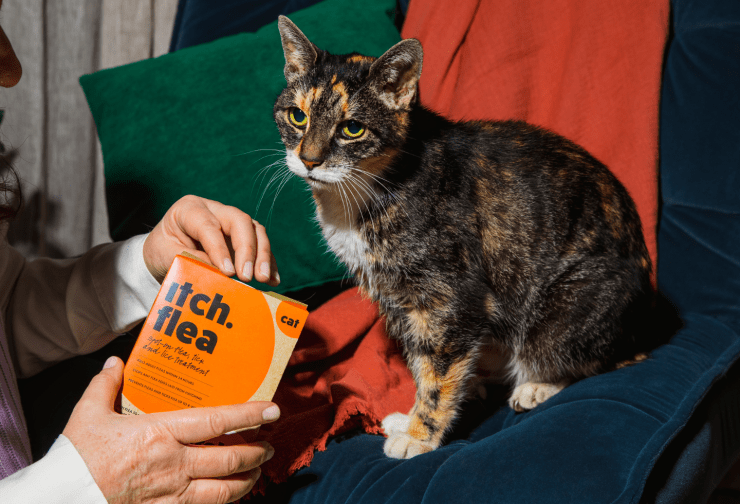Table of Contents

Watch our 'How to Apply' video
Here's how to de-flea like a boss
House rules

Table of Contents

Watch our 'How to Apply' video
Here's how to de-flea like a boss
House rules
Amazing news! When applied correctly, Itch Flea Treatment for dogs is 100% fast and effective at killing fleas on dogs and puppies!
However, the 'when applied correctly' bit is pretty important.
We know it's not always that easy, so we've put together a quick guide on the best way to apply Spot-On Flea treatment to your dog or puppy.
Follow these quick and easy steps below:
Opening the pipette: Hold the pipette upright. Then, snap off the tip.
Hitting the right spot. Part the fur at the back of your dog's neck, between the shoulders, until you see the skin clearly underneath.This bit is super important - if you can't see the skin, the drops will land on your dog's fur, which can reduce the effectiveness.
Give it a squeeze! Place the tip of the pipette on the exposed skin, and squeeeeeze all of that Itch Flea liquid out. Every last drop. Your dog might wriggle a bit (but to be fair, you probably would, too).
Wash your hands. Your job is done! You can wash your hands of the whole thing (well, for another month until their monthly treatment anyway!)
High five! You're well on your way to the flea-free life.
BUT - for maximum flea-killing-butt-kicking-strength, there are also some important house rules to remember:
Treat all of your household pets at the same time (ideally in the evening).
Keep them dry. Your dog can't get wet for 48 hours. No playing in the rain, no baths or showers, and no rolling in muddy puddles.
No heavy petting. Don't pet the area you've treated until it's completely dry.
No licking. Don't let the pet you've treated or other pets in your home lick the treatment area; another reason it’s important to apply the flea solution to the back of your dog’s neck.
Don't let your dog sleep on your bed with you the night they've been treated. Enjoy the extra room, and the fart-free air!
Whether it’s your Labrador, Cockapoo, Terrier, Spaniel, Collie, Golden Retriever, or any other breed, Itch Flea Treatment is suitable and tailored for all dogs.
Itch Flea kills all adult fleas on your dog in 24 hours and halts all other life stages. Delivered for free, every month, exactly when you need it.
Shop now


Great news! When applied correctly, Itch Flea treatment for cats is 100% fast and effective at killing fleas on cats and kittens!
However, the 'when applied correctly' bit is quite important…
We know it's not always that easy, so we've put together a quick guide on the best way to apply Spot-On Flea treatment to your cat or kitten.

Not all flea treatments are created equal. So it may be the treatment you used hasn’t done the job and you need to use something stronger. Itch Flea Treatment is a vet-strength, double action spot on treatment that not only contains Fipronil but also (unlike lots of other flea treatments), (S) Methoprene. Treatments that also include (S) Methoprene, like Itch Flea Treatment not only target the adult fleas feeding on your pets and kills them dead in 24 hours (and ticks in 48 hours), but also targets flea eggs and larvae, stopping the fast and furious flea life cycle dead in its tracks to stop new fleas developing.
We asked in-house Itch vet, Dr. Zoe Costigan to give us the lowdown on why your cat or dog might still be scratching after applying a flea treatment to your pet. Here's what she had to say:
“It’s fairly normal for there to be a period of hyperactivity amongst the fleas as the active ingredients in a flea treatment take effect and this can cause an increase in your pet scratching. It should settle down after 24 hours. If after 24 hours your pet continues to scratch, there could be other things going on. Your pet could be flea-allergic, it could have a skin infection or a hormone imbalance, or other conditions which can lead to itchiness.”

Dealing with a flea infestation can be a frustrating and exasperating experience, especially when you've tried everything but the fleas just won't seem to go away. It's a common scenario: you've diligently applied flea treatments, cleaned your home, and taken all necessary precautions, yet those persistent pests continue to bother your pets and invade your living space. If you find yourself in this situation, don't lose hope. Here we'll delve into the reasons behind failed flea treatments, how to identify signs of treatment resistance, and explore effective solutions to finally bid those relentless fleas farewell.